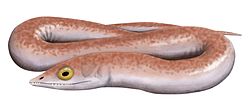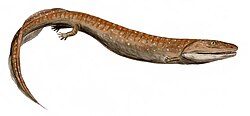| Whatcheeriidae Temporal range: Early Carboniferous | |
|---|---|
 | |
| Pederpes finneyae | |
| Scientific classification | |
| Kingdom: | Animalia |
| Phylum: | Chordata |
| Clade: | Stegocephali |
| Family: | † Whatcheeriidae Clack, 2002 |
| Type genus | |
| † Whatcheeria Lombard and Bolt, 1995 | |
| Genera | |
Whatcheeriidae is an extinct family of stem-tetrapods which lived in the Mississippian sub-period, a subdivision of the Carboniferous period. It contains the genera Pederpes , Whatcheeria , and possibly Ossinodus . Fossils of a possible whatcheeriid have been found from the Red Hill locality of Pennsylvania. If these remains are from a whatcheeriid, they extend the range of the family into the Late Devonian and suggest that advanced tetrapods may have lived alongside primitive tetrapod ancestors like Hynerpeton and Densignathus . [1] They also imply that a very long ghost lineage of whatcheeriids lived through Romer's gap, a period during the Early Carboniferous conspicuously lacking in tetrapod remains. [2]





